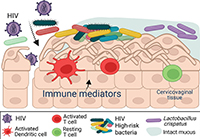

Zeroing in on vaginal microbes that most increase HIV risk
Nearly two-thirds of new HIV infections in sub-Saharan Africa occur in women, and a woman’s vaginal microbiome can influence her risk. In particular, an overgrowth of bacteria called bacterial vaginosis, or BV, raises HIV risk.
But not all BV-associated microbes raise HIV risk to the same degree. In new work published today in the Journal of Infectious Diseases, Fred Hutch Cancer Center scientists and a team of investigators from around the world report 14 BV-associated bacteria — and one immune protein — that put women at highest risk of HIV infection.
“The findings have several implications, particularly for prevention,” said Dr. David Fredricks, professor (Allergy and Infectious Diseases) whose lab helped to generate the data used in the study. “These markers could be used in risk stratification, for identifying women at highest risk of acquiring HIV.”
Once identified, these women could be guided to interventions, such as pre-exposure prophylaxis (PrEP) or antibiotic treatment, that may help reduce their HIV risk, he said.
While other studies have examined the relationship between the vaginal microbiome and HIV infection, the current work is one of the few studies to characterize the vaginal microbiome prior to detection of HIV.
It’s also the largest study that assesses how both inflammatory markers and the makeup of the vaginal microbiome contribute to HIV risk.